Episode 123: Jane's Hoya tour
(left to right) Hoya macrophylla (or possibly H. clandestina…) Hoya ‘Mathilde’ and variegated Hoya carnosa. Photograph: Jane Perrone.
Transcript
Episode 123
[music]
Jane: Hello and welcome to On The Ledge podcast, episode 123. It's 2020! This week I'm bringing you a tour of my Hoyas because I know that you guys love Hoyas and I answer a question about an Aralia called Fabian - sounds like a Bond villain but it is actually a plant!
[music]
Jane: Welcome, welcome, welcome! It's another episode of On The Ledge! You've clearly missed me because quite a few of you have become Patreons over the festive hiatus of the show. Travis, Porsche, Wendy, Trent, Kristin, Mariah. Yes, I know it's starting to sound like the best super-group ever, but we'll keep going: Ed, Michelle, Marion, Margaret and Natalia all became Ledge-ends, Justin became a Crazy Plant Person and Ellie upgraded her pledge from Ledge-end to Superfan. Thank you to MiaowKitty12345678 and JustSimplyMe for lovely reviews of the show and a quick note about the On The Ledge sow-along which is coming up soon.
If you have been listening to the show since the start, you'll know that every spring, around March time, we do a special project which you can all get involved in, sowing seed to grow house plants. It's huge fun. It's a really great way to take your house plant skills to the next level. So I really hope that you'll join me for the OTL sowalong 2020.
There's going to be a new element for 2020, sowing spores to grow ferns, which is a really exciting one, so I hope you're going to be interested in that. I'd also love to hear from anyone who took part in the very first On The Ledge sowalong, which was in 2018. If you've got plants that you grew during that sowalong that are now mature and looking lovely then I want to know. Perhaps you've got a plant that is now pride of place in your collection. I'd love to profile that in the show, so get in touch and let me know.
[music]
Jane: I know, very well, that you guys love Hoyas. How do I know? Well, the episode that I did with Doug Chamberlain of Vermont Hoyas, that was episode 82 if you remember, was hugely popular and still is. In fact, at the last count it was the second most popular episode I've ever made of the show. So I thought it was about time to bring you a little bit of chat about the Hoyas that I own. There are a dozen of them, they're spread around my house and I'm very pleased to say that they are bringing me a great amount of joy.
I recently got my hands on a fabulous book about Hoyas which I highly recommend if you are really getting into this particular genus. It's called The Genus Hoya - Species and Cultivation, by Anders Wennström and Katarina Stenman. I hope I've pronounced their names correctly. I reference the book a few times in this chat, so do check out the show notes if you want to get yourself a copy. It's a brilliant guide to many of the Hoyas that you will be growing and well worth the investment, so do check that out. So I'm going to pop inside now, come and join me and let's talk Hoya.
[music]
Jane: I have gathered the Hoyas from all around my house and brought them here to take a look at them all and to give you a guided tour, just because most of them are up quite high and hard to look at and talk about at the same time. So here we are with the Hoyas. I thought I had thirteen, but I think actually, unless I've forgotten one, which is entirely possible, that I have a dozen of these things. Let's talk first about the one that I've had the longest and that is my variegated Hoya carnosa. Let's be fair it's a shadow of its former self, if you listened to the Hoya episode with Doug Chamberlain you will remember that my Hoya carnosa suffered a terrible fate which was that I allowed some completely white leaves to grow, there was a stem that had completely white leaves on it and nothing else. Rather than judiciously cutting those off, I decided to leave them to grow and it suddenly sent the plant into a tailspin and I just about managed to save a single cutting which I then replanted in a pot and this is what I've got now. It's not doing so badly, it's already flowered and the single cutting has branched into two different stems and is looking reasonably good.
Let's just describe this Hoya, it's probably the most common Hoya that you see out there, what most people would call the Wax Plant or Wax Flower. It's got the standard leathery leaf that you'll be familiar with in the Hoya family. I don't know exactly what variegation this cultivar is actually called, but it's the one with creamy white edges and a slight silvery splash in the centre. The leaves are, I would say, fairly standard thickness, they're a tiny bit furry and it's a very attractive plant and I'm glad to say it's growing really, really well. If I see any of those white leaves though, the first thing I'm going to do is get rid of them because, as I said before, it was bad news when this happened. So this is doing pretty well now. I think what I'm probably going to do with this plant is take a cutting come spring because I would like it to bush out a bit more and have a bit more growth going on in the pot.
It's doing the classic Hoya thing, people worry about this, but it really is totally normal for Hoyas and, in fact, many plants that scramble and climb about, which is putting out completely bare stems with no leaves on them at first and you start to panic and thin "Where are my leaves?" but what the plant is doing, well, I think I've read this somewhere, but perhaps a botanist can confirm this for me, they put out feelers to see whether it's a good place for them to grow and then once that's confirmed that they're happy in that little extra ground that they've colonised then they start putting out the leaves, so they don't really waste any energy before expanding into new areas. What you also notice along the stem of the Hoya, this particular Hoya and many others, is bumpy bits which again can be a bit alarming, you might think you've got scale, but it's actually just adventitious roots which will pop out and then really start to grow if they come across anything that they can root into. So this one's obviously hanging so there's nothing for it to root into, so those adventitious roots tend to stay quite small, but they're not a problem. They're just there waiting for the opportunity to root into something. So that's my Hoya carnosa. The flowers on this are shell pink, furry, they're the thing that got me into Hoyas in the first place because they are so unusual and gorgeous and they flower quite easily, as I've already said. The flowers are great, the foliage is great, it's a really lovely plant and if you have only one Hoyathen Hoya carnosa is a good choice. It's easy to get hold of too, which is not true of all the Hoyas we're going to talk about today.
From the sublime to the ridiculous, we're going to look at Hoya linearis. If you remember, this specimen of mine came from James Wong, as a cutting when I visited his place and it's done really well. I've taken a lot of cuttings off this plant and yet it's still quite big and lush now, relatively speaking, given how long I've had it. It is very, very dry right now. I think I need to give this a good water because it's starting to get that very dull look that plants get when they are in need of some drinking. It's also quite light to pick up, so I know that it is a thirsty plant. This will be repotted in the spring because I can see lots of roots coming through the bottom of the pot. What is it I love about Hoya linearis? Well, as the Latin name suggests the leaves are really unusual. They're about a couple of inches long I'd say and they look a bit like runner beans. I know you don't call them runner beans in the US, a bit like, what do you call runner beans in the US? I've forgotten. Green beans! They look a bit like green beans and they're actually rolled in on themselves and you get a little groove down the centre and they're rather softly furry, they come out either side of the node and you get these long strings hanging down and they really do look very different from any other Hoya that you'll come across. I guess that that adaptation is so that they can preserve water and this Hoya does like to be kept on the dry side.
What you'll find with the stems on this one is that it does produce leaves straight away unlike the Carnosa, but they tend to grow up the stems until they get heavy enough to start trailing down so you end up with this weird effect, where you've got arms reaching up and then gradually they will drop down as the plant matures and they get long enough that they start to hang. The flowers on this one tend to flower, for me anyway, towards the end of the summer, during autumn time. The flowers on this, they've got a lovely scent which comes into its own about seven o'clock in the evening. They smell a buttery lemon smell, really delicious, the flowers are really adorable, they are pure white and they tend to be visible among the clusters of leaves. Again, this is reason to have this plant hanging because it does look really great when viewed from below. This one grows in places like India and Nepal and it's not the easiest of Hoyas. I've never had any problems with it, but if you have a feeling that you are the kind of person who gives a plant too much water, you may struggle with this one. So just take care on the watering side and make sure it's really well drained, but this is one of my absolute favourites and I wouldn't be without that particular Hoya.
One more fairly mature plant to talk about, and that is Hoya Mathilde. Now this is a hybrid, it's a cross between Hoya serpens and Hoya carnosa and this one came as a cutting. I can't remember who gave this to me. I think it was on a UK house plant swap Facebook group. Again, if you are going to start off with Hoyas and you want something quite easy to get going with, I think Mathilde is a really good choice. This plant has small roundish oval leaves with silver splashing on them. It's hard to generalise with Hoyas because the leaf shape does change. I find that sometimes that the leaves can be quite elongated and other ones are quite oval and that changes as the stem matures. This one hasn't flowered yet but I just love the look of it. It's desperately in need of being trained around a hoop so I can really enjoy the foliage up close. The flowers on this one, it looks very much Carnosa, except the flowers are white and fuzzy rather than pale, pink and fuzzy. According to Wennström and Stenman, this flowers early and often, so I'm still waiting for my flowers but I'm hoping they will come fairly soon. But even if it never flowered, I think I would still be in love with this plant. It's really, really beautiful.
I propagated a cutting of this using the hummus tub technique, thanks to Sally Williams for highlighting that brilliant technique for me, and it worked really well for this plant. The only thing is you end up with roots coming from every node so what I would do once its rooted is then lay it on some compost and allow it to root. But it's a really easy plant, you can't go far wrong with this, and apparently the scent is quite like Hoya carnosa, I've never got any scent at all out of my Hoya carnosa, so that's not very informative. I'm not too worried about the scent. I think if it's got beautiful flowers then that's quite enough for me. So those are my three biggest plants but I've got some other ones to tell you about.
The next one is a bit of a mystery but it is possibly my favourite Hoya that I've grown so far. I'm going to call it Hoya villosa, but like a lot of Hoya taxonomy there are arguments about the name of this plant. There is discussion about whether Hoya globulosa and Hoya villosa are in fact the same plant. I'm going to call it villosa because apparently villosa has wavy edges to the leaves whereas villosa doesn't and mine definitely has wavy edges so I'm going to go for the name Villosa. Why do I love this Hoya? Well, the leaves - they're quite big, they're sausage-shaped about ten, twelve, fifteen centimetres long and underneath they are deliciously hairy. Just very, very soft tiny hairs covering the surface which makes them very tactile because on top they're lovely, glossy and smooth. One of the finest points about this foliage is that the veins are very apparent, there's this amazing crocodile pattern, where the veins are dark and the space in between is slightly lighter and it's just really gorgeous, I'm really enjoying the foliage on this one and you can't stop stroking the underside of those leaves.
So this a cutting that I got from Tommy Tonsberg, the wonderful Norwegian grower that we heard from quite a few episodes ago. I'll put a link to the show notes to his episode in there. He was very kind enough to give me lots of Hoyacuttings and this has taken beautifully and is doing really well. It's doing that thing as I've already described, of putting out the leaf stem and then the leaves are following, it's just starting to produce some new leaves, but so far this has been super-easy. I just potted up the cutting once I'd rooted it and away it goes. It's absolutely fine. I just can't get enough of this one! The flowers on this one, they're pale lemon yellow and white. I haven't seen this one flower yet, but I'm hoping it will. Apparently, according to Stenman and Wennström, it's easy to grow but it doesn't produce a lot of flowers. Well I don't care because I'm just in love with the foliage. Apparently, this one likes quite a lot of sun and then appreciates a cooler period during the winter. I have to say mine has been in quite deep shade so far and it's doing absolutely fine. It's not fussed about that at all, so it's pretty tolerant.
[music]
Jane: We'll be back for more of me wigging out about Hoyas shortly, but now it's time for Question of the Week, which comes from Michelle and this one came in on Twitter where I'm @JanePerrone and Michelle has a Fabian Aralia and she has a problem. The problem is that her plant has got what I describe as a serious case of leggyness: lots of bare stems, leaves at the top and possibly not the most pleasing of shapes. So Michelle is wondering if she can encourage growth of a new stem at the bottom of the plant? Now this is fairly typical of Aralias. They do tend to drop their lower leaves at the drop of a hat if they're not happy with conditions and unfortunately there isn't a super quick fix for this problem. It's one you're going to have to tackle over a period of time.
I would suggest waiting until spring, Michelle, so talking about early to mid-March before you do anything. In the meantime just try to keep the plant as happy as possible. They need reasonably high humidity and it doesn't like to get too cold over winter either. But if you can give it reasonably good conditions until spring time, then what I'd advise doing is, one at a time, I would take the leggier stem and cut it right back to just above a leaf node. This is scary to do but I think this should promote new growth from the base of the plant. If you want to be really brutal you could do two or even all three of the stems at the same time but that way you're risking everything because the plant might just keel over and die. This way it still has some leaves to gather energy via photosynthesis, you will get new growth hopefully, once that growth is under way and established, then you'll be able to cut back the other stems as the plant recovers. You can then reshape the whole plant that way but it is going to take a while. It might take up to a year to get the plant exactly right. If you let conditions lapse with this plant it will protest very quickly. So it's one that you're going to have be in for the long haul, Michelle. Most house plants, if you want to promote new growth, you are looking at cutting them back. That is how they are stimulated to grow more - by being cut back. Whenever you're doing that, just make sure you're using a really sharp and clean knife or pair of snips or pair of secateurs, so that you're not passing any infection from plant to plant, make a clean cut. By cutting just above a leaf node it means that that's the point where the new growth will develop from and you won't get a length of stem that rots off above the node because it's just hanging around there and it can't really do anything. So, give that a try, if you've got any plants that are getting leggy, try cutting them back. What's the worst that can happen? You lose the plant. Well, if it's not looking great in the first place, then it's a really worthwhile experiment and I would definitely give this a go with your Aralia, Michelle, and as I say, the other thing to do is to make sure it's as happy as it can possibly be. I hope that's helped and I do hope your Fabian is back in rude health very soon.
I had one other question that I wanted your help with. Ashley got in touch about her Rhaphidophora tetrasperma. Ashley is worried. Don't be worried Ashley - we will solve this problem! There are dark green patches underneath the leaves of her Rhaphi as I like to call them and it's undergoing heavy guttation. Ashley says the soil seemed quite dry so she'd given the plant some water at the bottom of the pot, which sounds like a good practice, and it's been a couple of weeks since she's last watered. She's worried whether the plant is okay, I'll put a picture in the show notes of this plant with its dark green patches. Immediately as I read this email I rushed off to look at my Rhaphidophora tetrasperma to see if it had the same patches, but no, the backs of my leaves just plain pale green, so I'm not sure what's going on here. This plant is under a growlight with Ashley's other aroids and she doesn't understand what the green patches are about. So, my theory on this one is that it's some kind of form of edema. There's been an overwatering incident at some point and that has caused problems in the plant's cells which has caused these patches, but I'm not totally convinced by my own theory and I'd love to know what you think. Ashley thinks that the dark patches weren't there prior to watering, which is important to say, otherwise I might be opting for the idea that it's some kind of variegation but I don't know. I would love your thoughts. It's a bit of mystery, this one, so do get in touch if you've got an answer to Ashley'sRhaphidophora problem.
That's all for Question of the Week. If you've got a question that I can help with, a plant ID, a mystery bug or something odd happening to your Oxalis, I want to know. Let's get back to the Hoya talk and it's time for a small Hoyawith a large name.
Jane: Okay, moving on. Now we're on to one of my smaller cuttings. Again, thank you Tommy Tonsberg for providing so many beautiful plants. Now this one is called, I'm going to have to look at this carefully because it's a long one, Hoya kanyakumariana. This one comes from India, it's got quite small - about 2cm by 2cm leaves - in a reverse heart shape, so the thinnest bit is where the leaf joins the stem, I guess you could say teardrop shape. That's simpler to say. The leaves are very wavy and undulating with a very slight silver fleck. This one is a good plant if you don't have a lot of room. This plant does stay pretty small. So if you don't have room for one of the more expensive Hoyas then this is a great choice. Apparently this one is a good one for sunny conditions and dry air, which is excellent, although I know, in this room, I don't have a lot of problems with dry air, it's usually about 50 to 60 degrees. If you do have a dry room then this might be a good choice for you. Apparently it doesn't take too long for the plant to reach flowering size, so that's good news. My cutting is about 10cm long right now, so looking forward to that. So far it's given me absolutely no trouble at all. It's just doing its thing and establishing lots and lots of roots and no doubt I will be seeing lots of growth soon. Lots of people panic when they pot up a cutting and then nothing happens and it just sits there. Of course, something is happening, the roots are growing below the surface, so you just have to be a little bit patient at this stage. I'm sure, in the springtime, this will really start to come to life. Okay, let's move on to the next one.
We've got a Hoya that has really thick and chunky leaves. It's Hoya obovata. This one sometimes gets mixed up with Hoya kerrii because the leaf shape is a little bit similar, but the leaves of this, they are not quite round, very, very thick, with a silver stippling on them. This is from Indonesia. I have heard from some listeners it does grow quite big. Right now, my cutting has got three leaves on it and it has literally done nothing above the surface since I got it, other than do a nice bit of rooting itself, so can't wait until Spring to see this really spring into life. The leaves are pretty but I'd like to see the flowers too. They're red and white and that would be nice to see some flowers. Apparently, this is easy to grow and flower, so I'm looking forward to seeing the results. Apparently, the other thing that's good about this plant is, unlike Hoya kerrii, it doesn't produce lots of red nectar which I know some people find very troublesome about Kerrii,so that is a plus for Hoya obovata.
Okay, next up, just looking round the corner here, yes Hoya fungii. I think it's fungii anyway. That's how I've identified it. If you look at the show notes and say: "That's not fungii," then please let me know. So what can I tell you aboutHoya fungii? Well, the most interesting thing so far, has been that the new leaves it's produced, every single set of new leaves has been a different shape. So the cutting I got, the leaves are quite rounded on the very first node, they're very rounded. The second lot of leaves were small and pointy and then I've got a really round set of leaves, then the latest leaves are really long again. So I think that the Hoya genus as a whole does seem to have this tendency of changing its leaf shape according to conditions which is rather interesting. Hoya fungii, a bit like the Villosa we were talking about earlier, has prominent green veins with pale patches in between. This seems to be particularly prominent on the newer leaves, I've got the single cutting here, it's doing rather nice, it's just throwing out a new stem and I think I'm looking forward to seeing how this one develops. It's known as a plant that is good for beginners, quite easy, can put up with a bit of frost even. It's a plant you can have outside for quite a large proportion of the year, if you live in a climate like mine, which is temperate. It's got white flowers with a red centre and it's supposed to have a sweet fragrance, so I'm really looking forward to seeing how this one develops. Right now, it's doing nicely. It's not my favourite in terms of the leaves, the leaves are a little bit dull, but if it has great flowers, then that is all I need.
Okay, now we're on to the smallest of my Hoyas which is Hoya curtisii - again from the lovely Tommy Tonsberg - this is a really tiny leaf, the leaves are about, I wouldn't even say they're a centimetre across, they're half-a-centimetre across splashed with silver, dark green - they're rather charming actually. Each leaf has a sharp point at the end of it and I think, as it grows, it's going to turn into quite an interesting plant. This comes from Malaysia and again, if you like a small-growing plant, then this is another one that would be ideal for you. Wennström and Stenman in their book, which I shall put a link to in the show notes, recommend putting this in a shallow wide dish or pot because it has quite a scrambling way of growing. Inevitably for me, mine is not in that form of pot, but it is in quite a small container and so far it doesn't do a lot - it's just sat there. I'm hoping for some really nice growth this spring though. It's a really pretty plant, if you like something like Ceropegia woodii then you might like the way that this plant looks. The flowers? The flowers are cool on this one. It's got this amazing combination of lime green and pink and it looks a little bit like a tiny shooting star. So rather a cool flower. Looking forward to seeing that.
We've got four left to look at. Here's where we get a little bit vague because I have two specimens which, well, as I've already indicated, the world of Hoyas taxonomy is a complicated one. I've got two plants here which I'm not quite sure what they are. I think one of them is Hoya davidcummingii I guess there's a guy called David Cumming, who was involved in Hoya research! This is a plant that comes from the Philippines. It's only a small cutting, this one, and so far it's not doing great. The latest growth, the leaves that I've got supporting it right now, are a little bit distorted. I'm not sure what's caused that, it is starting to put out some new growth though, so we'll see how that goes. The leaves are really quite thick and very inflexible, you can't bend them at all, they're very, very rigid, they're darker at the edges and paler in the middle with a very pale underside. Apparently, it's got a buttery scent. I like the sound of that. This one is not recommended for a beginner, oh dear, because it isn't the easiest to flower or grow. What else do we know about this one? The flowers are dark red and yellow and sound quite nice. It'll be interesting to see how I get on with this one and if indeed it is a Hoya davidcummingii - if anyone looks at the picture and can tell me otherwise, I would love to know. There are a few Hoyas like this that are quite similar looking, so it's pretty easy to get these ones mixed up. Also, lots of the names have changed and this is where the next Hoya comes in.
I think this plant is one that's known as DS70. There is a lot of confusion around this plant. There seem to be many names that it's called by, including Tsangi, Odetteae, but I'm looking at it and my best intelligence is that this plant is the Hoya known as Hoya DS70. Not the most exciting foliage. It has got a more prominent pale vein, mid-rib veins this time, with darker surrounds for the leaves and it's got red and yellow flowers. It is a good one for beginners apparently and it does flower freely, so I'm hoping these two cuttings I've got, which are already putting on really good growth, will continue to thrive. They're doing alright. DS70, I salute you! I hope that you grow well!
More taxonomic confusion ahead. Let me grab this Hoya. This is most often sold as Hoya macrophylla variegata (Oh, hello Wolfie! Don't run into any Hoyas please, dog. Hello darling. Have you come to see the Hoyas? Yes, they're very nice. Oh, are you tired? Why are you tired? You've been lying on the sofa! Go and lie on the sofa now. You want to be stroked? Okay, let's stroke you while I talk about this Hoya.) This is Hoya macrophylla. I think this is really up there with the villosa, running close second for my most popular Hoya. I was very confused when I looked around for this plant's name because most people seem to call it macrophylla variegate. It's got beautiful cream edges to the leaves and a wonderful venation on the leaves, where the veins are pale and much paler than the flesh in between and there's that standard silver splashing. It's a really beautiful plant. When the sun is out, you also get little shades of red coming into this leaf. It's really gorgeous. I'm really happy with this one. (Wolfie, please don't knock Hoyas over!)
Hoya macrophylla, we thought, but then I started to see sometimes that this plant is actually called Clandestina and when I looked in this lovely Hoya book, that seemed to be the suggestion, that what I was growing was Clandestina, even though it's often sold as macrophylla, but from what I can see right now, and that may change as I learn more, but it does seem to actually be properly named Clandestina in that actually there is a macrophylla but it's not very popular and the one that is around is Clandestina. How confusing! Anyway, this a plant from Indonesia and it's recommended as an easy one to grow and it is indeed a really beautiful plant. I haven't had any flowers yet, but they're off-white colour, apparently, not much scent and in fact I don't care if this plant flowers because the leaves are just so incredible; really thick, particularly in the older leaves, they are about 12cm long. (Wolfie, you've got to stop doing this. Come on! Right, the dog has been exiled while I finish recording this.) So, yes, a macrophylla slash Clandestina. What beautiful leaves this plant has. I'm really looking forward to seeing this grow. It's grown so well since I got it from Tommy Tonsberg. I'm really excited to see how it develops. I recently potted this up into terracotta and it seems to be doing absolutely fine. I'm going to train it into round a hoop I think to make it look nice. So that's a good one to try if you can get your hands on it. The non-variegated form is pretty nice too, but the variegated form, if you like variegation, is very beautiful, so definitely worth a look.
Finally, that darling of Instagram, Hoya kerrii. I was gifted a couple of small plants from the wonderful North One Garden Centre. I have to say, so far, I haven't done particularly well with them. Quite a few leaves fell off. I repotted them into a single pot and I think I oversized the pots, so they got a little bit of root rot. As I understand it, this is a real problem for these Kerriis. So if the name doesn't ring a bell, these are ones that are sold as heart shaped leaves, individual leaves, stuck in a pot, often around Valentine's Day, but they do grow into lovely vines if you can get them to grow. This needs full sun. I need to put this into another position and hopefully, now that I've got the watering right and given it more light, this will really start to thrive, but I've been struggling so far with this variegated Hoya Kerrii. Oh, I've just dropped compost everywhere in my excitement! No matter, I'm always dropping compost somewhere! So this is a plant that I will continue to battle with and hopefully get it to thrive. I think it's got plenty of potential to be a really lovely plant with these gorgeous leaves that are heart shaped with cream variegation around the edges. So very sought-after plants. I really hope I can make it thrive. It's going to go into a sunnier spot and we'll see where it takes us. I will keep you posted.
It is a plant that flowers reasonably easily with these amazing flowers with furry white corollas and then a central red corona which is where this red nectar comes from, which can be a bit of a pain if it drops all over your carpet, so that's one thing to beware with Hoya kerrii. But, you know what, I know there's all this craze about Hoya kerrii, but I think there are so many wonderful Hoyas out there that if you can get your hand on any Hoya then these plants really are a treat to grow. So that's my Hoya collection, I really hope I've got all of them I think I have! I'm really pleased with the way that this collection is growing and I'm really keen to add more to my collection because, looking through the internet, YouTube and books and information about these plants, there's just so many amazing ones out there. So I would love to know what Hoyas you are growing and how they're doing for you. If anyone in the UK is interested in a bit of a swap - I might be able to send you a bit of linearis in exchange for something else that I don't have - then please let me know because it is so much fun to grow these plants.
Jane: Phew, that's a lot of Hoyas, but I want more, yes, I must have more! Sorry. I momentarily let the mask slip there and revealed my true, horrible Hoya obsession! Anyway, I love Hoyas as you may have grasped and I hope you do too. Check out the show notes at JanePerrone.com for pictures of my plants and also for details of that wonderful Hoya book, The Genus Hoya, which I highly recommend you get your hands on. If you're looking for advice on cultivation of Hoyas, do go back and listen to episode 82 if you haven't already. But they're also incredibly tolerant plants. This is why, perhaps, they've not been as popular in the garden centres as other house plants because actually, once you've bought one, you've probably got it for life because they are just so tough. So, celebrate the Hoya because these plants are truly wonderful and if you look after them they will be with you for decade after decade.
It's meant to be Houseplant Appreciation Day today, but, as everyone who listens to this show will know, every day is houseplant appreciation day! But do take a moment to enjoy your plants and recognise all the joy they bring into your life. And maybe spread the word by offering a non-planty friend a cutting or a baby plant so that they too can learn what you've learned - plants make people happy! Bye!
[music]
Jane: The music you heard in this episode was Roll Jordan Roll by The Joy Drops, I Snost, I Lost by Doctor Turtle and Whistle by Benjamin Banger. All these tracks are licensed under Creative Commons. See the show notes at JanePerrone.com for details.
Subscribe to On The Ledge via Spotify, Apple Podcasts, Player FM, Stitcher, Overcast, RadioPublic and YouTube.
The Genus Hoya by Anders Wennström and Katarina Stenman.
My Hoya collection has grown and grown since I first acquired a variegated Hoya carnosa many years ago, which reflects how much I love this genus of vining plants. And I know you love Hoyas too, because episode 82, in which I talked to Doug Chamberlain of Vermont Hoyas, remains my second most popular episode!
So in this episode I give you a tour of my Hoya collection - some mature plants, some young cuttings - to find out how they are getting on. I explain why I love them all and try to identify them all, but Hoya taxonomy is a bit tricky, and seems to be constantly evolving, so if you think I have got any of them wrong, let me know!
I recently bought a great book on Hoyas recently: The Genus Hoya by Anders Wennström and Katarina Stenman. I bought my copy from the author via eBay - it’s a good resource if you want to extend your knowledge of Hoyas.
Many thanks to Tommy Tonsberg (my guest back in episode 68) for gifting me so many cuttings, and to N! Garden Centre in London for gifting me a variegated Hoya kerrii. Also scroll down to find out what I suggest for a leggy mina aralia in this week’s Q&A.
Check the photo gallery below as you listen to match pictures of the plants with my descriptions!
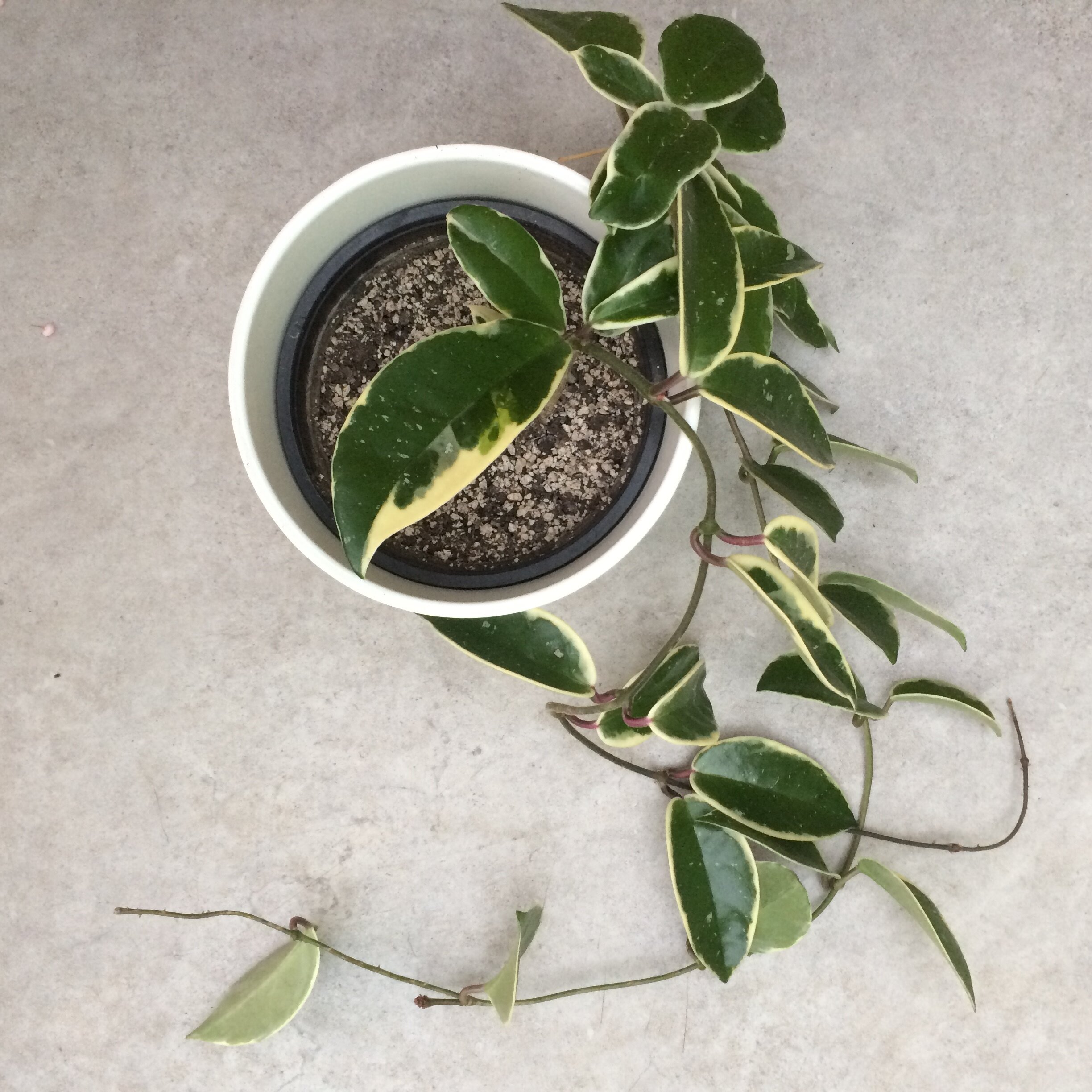
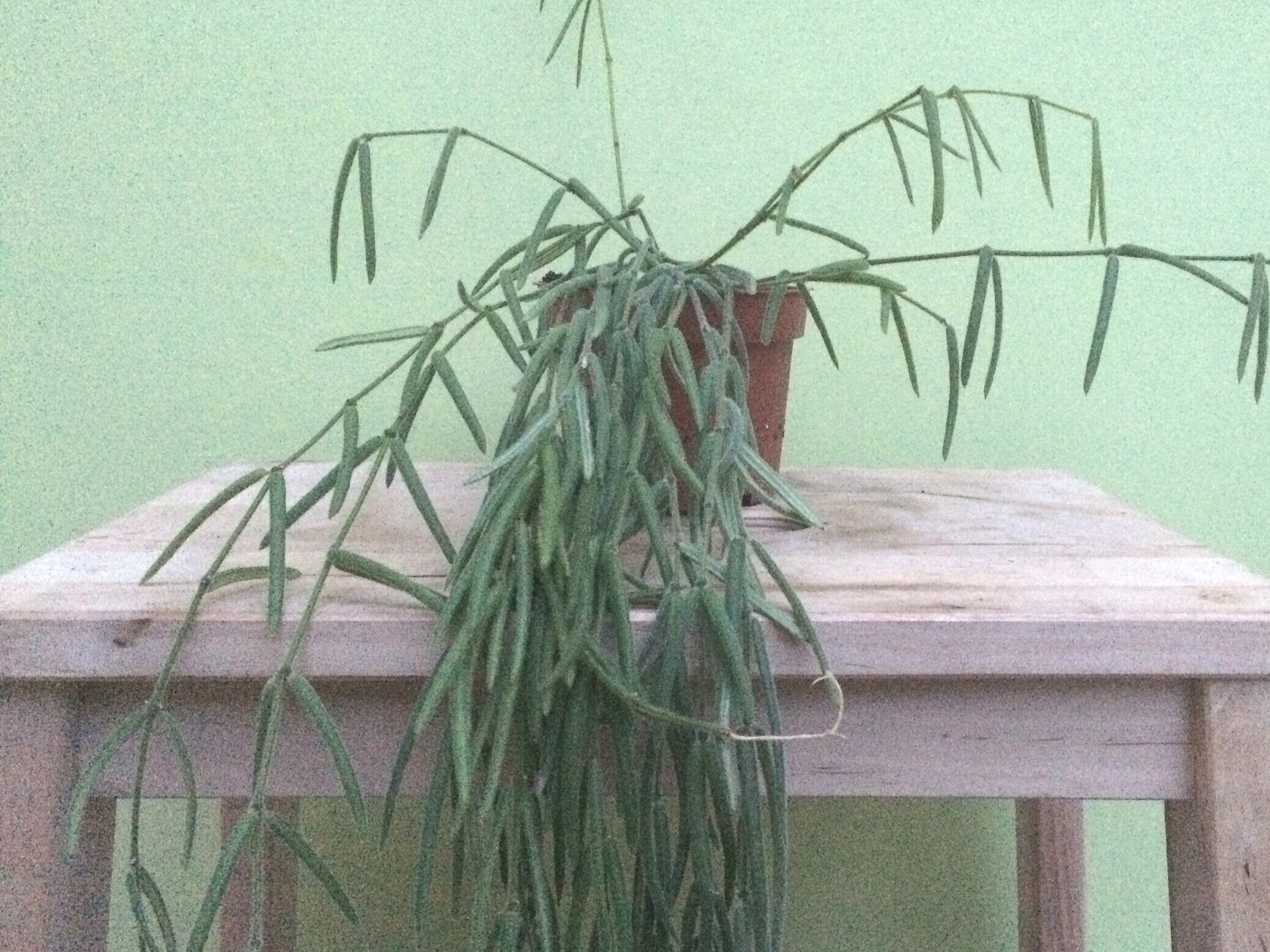
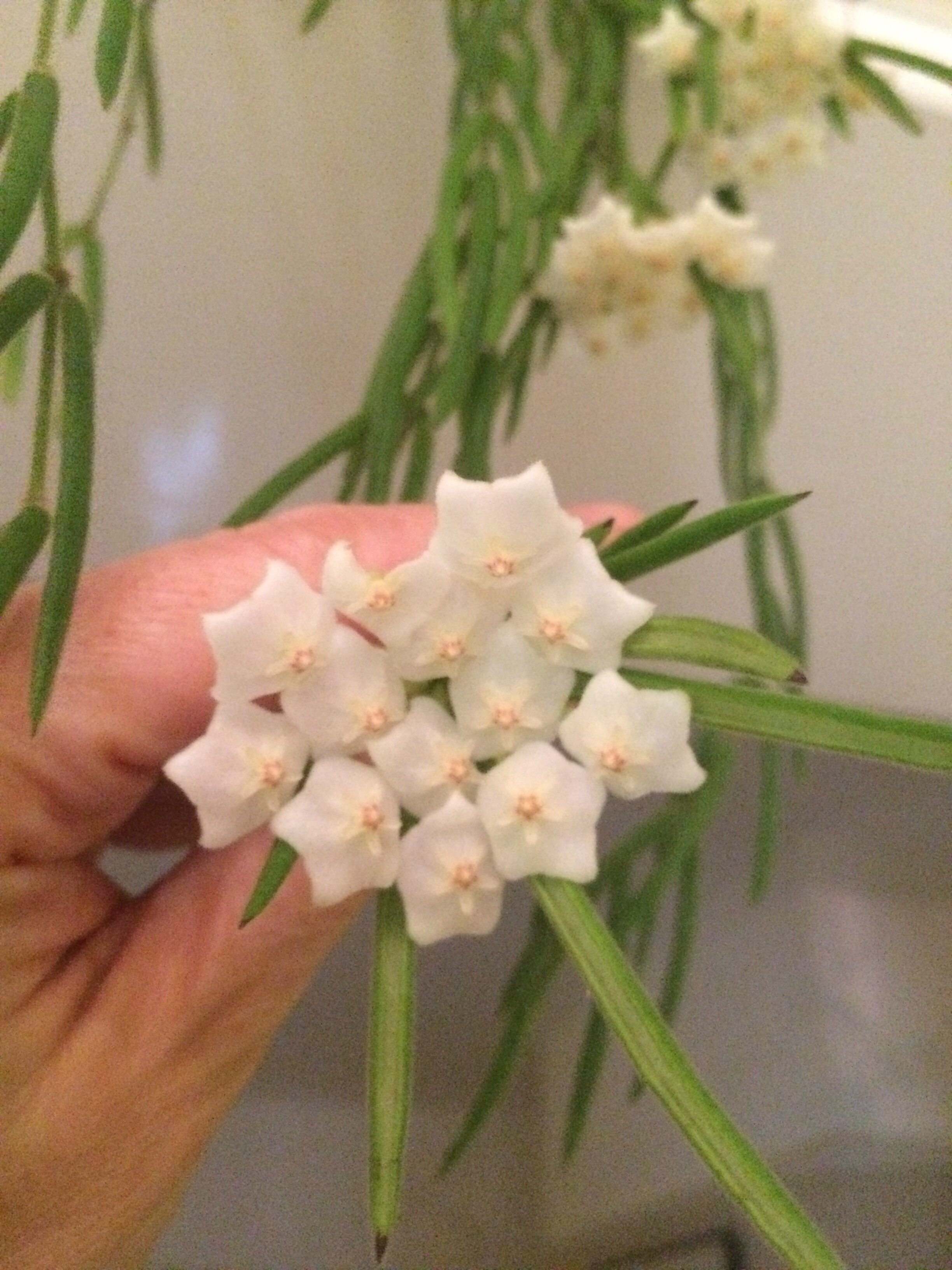
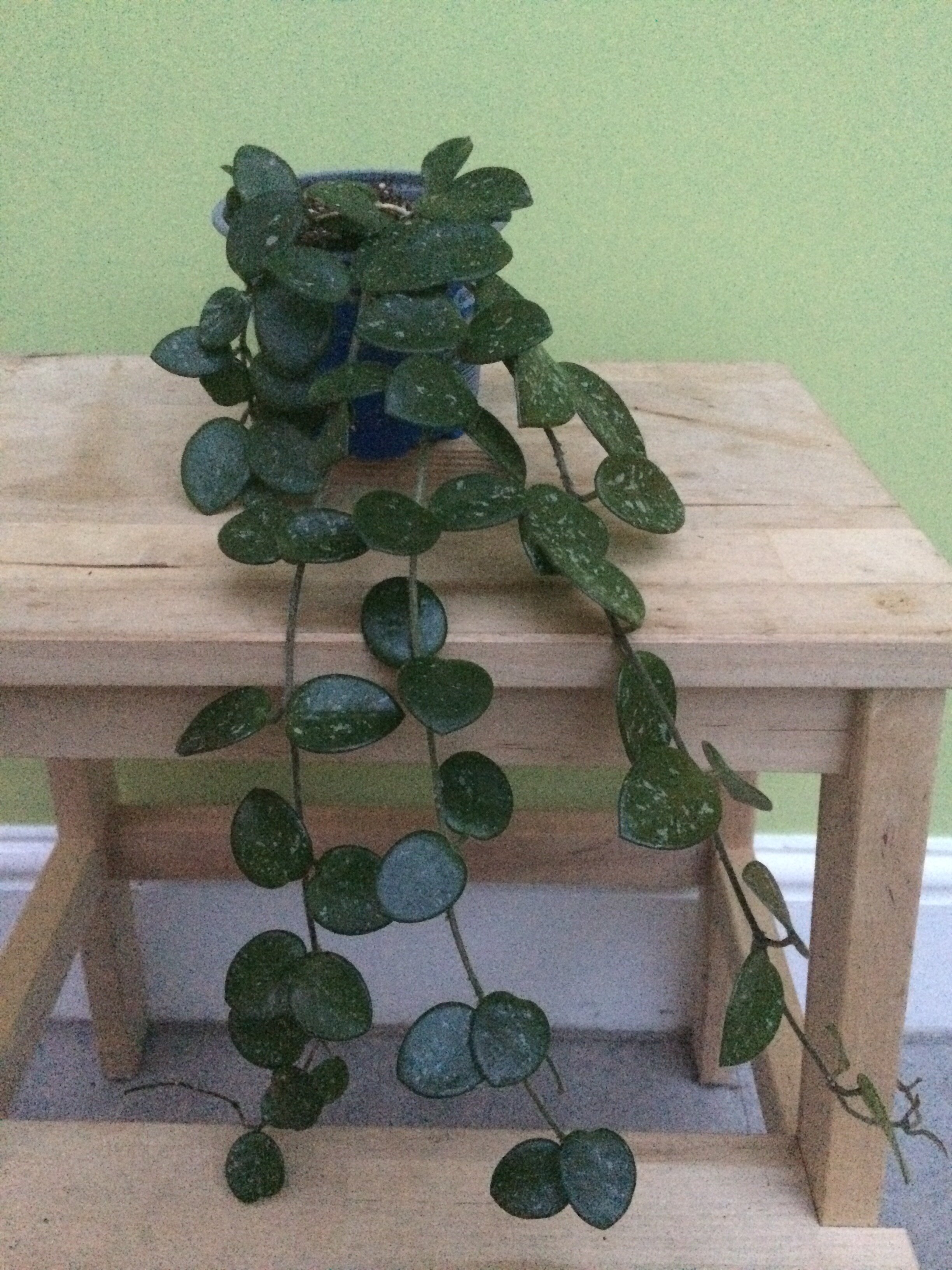

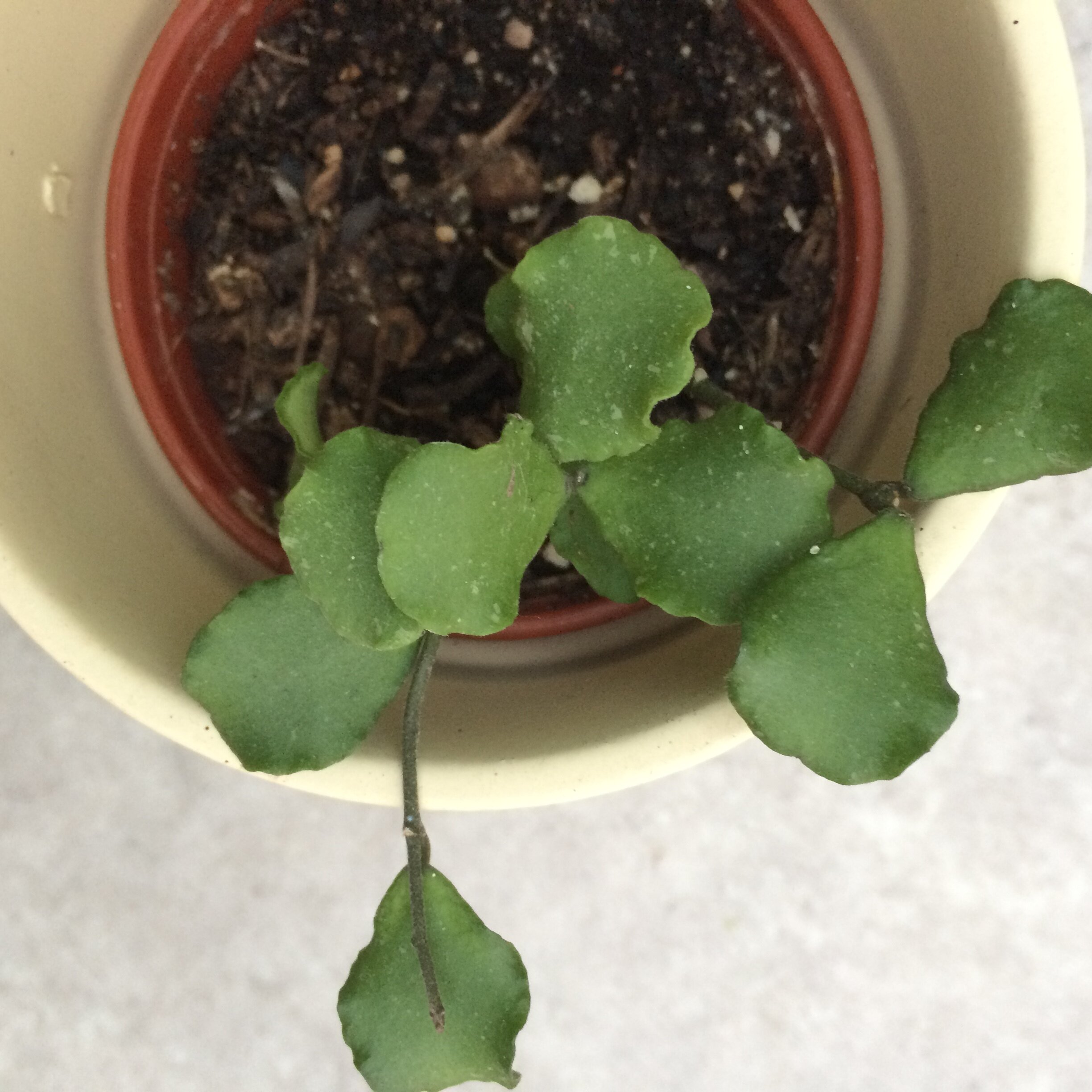
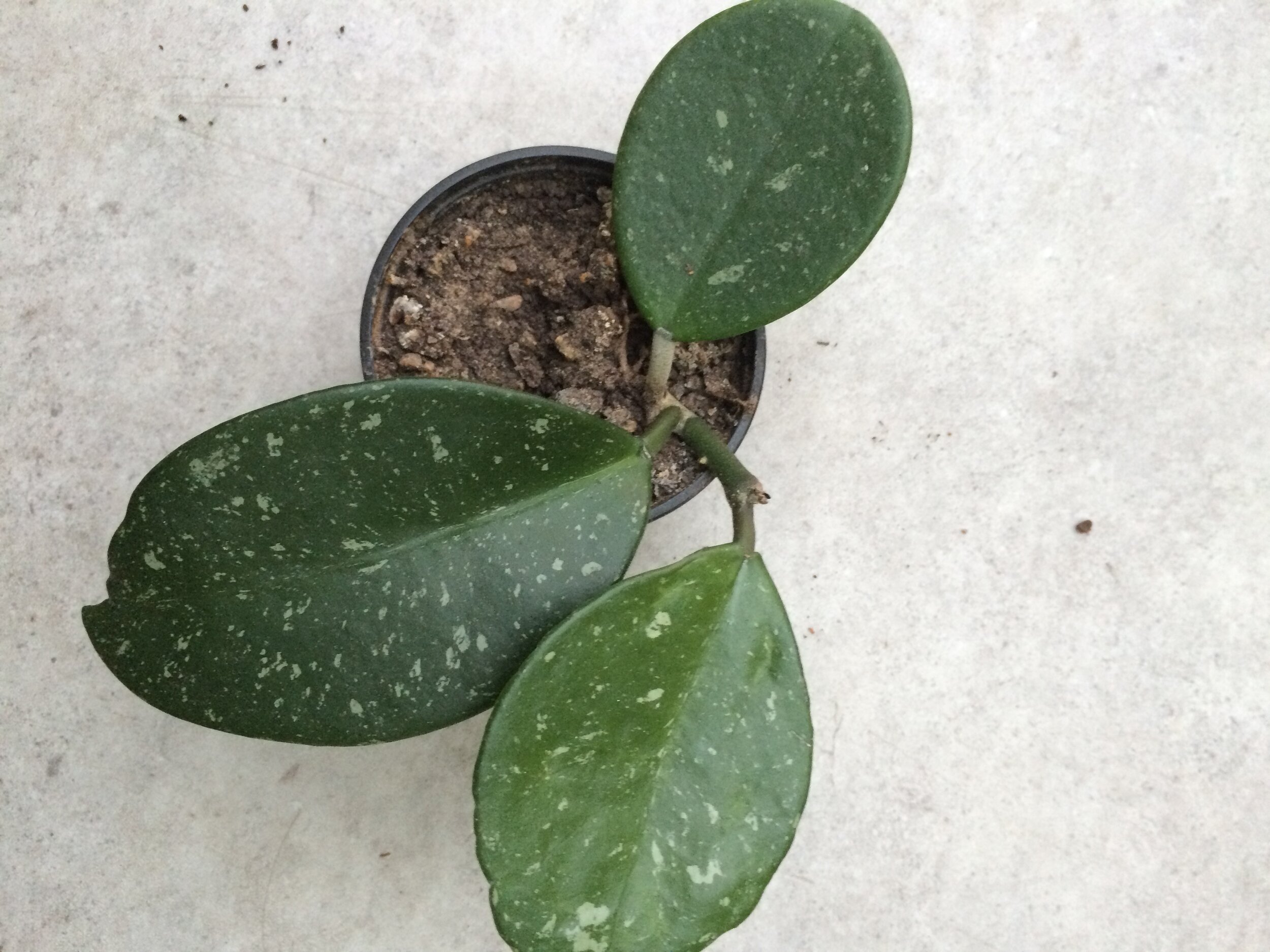
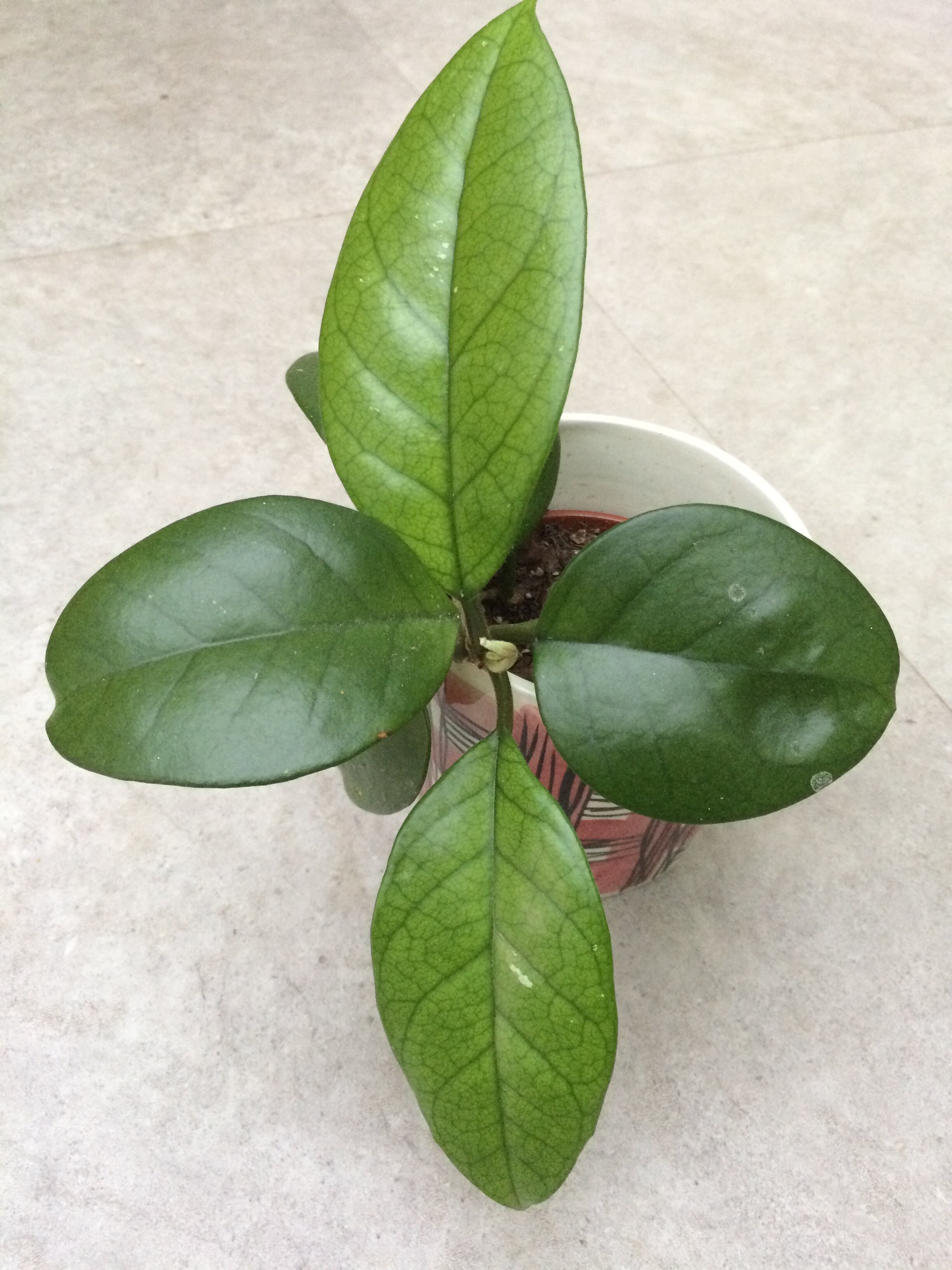

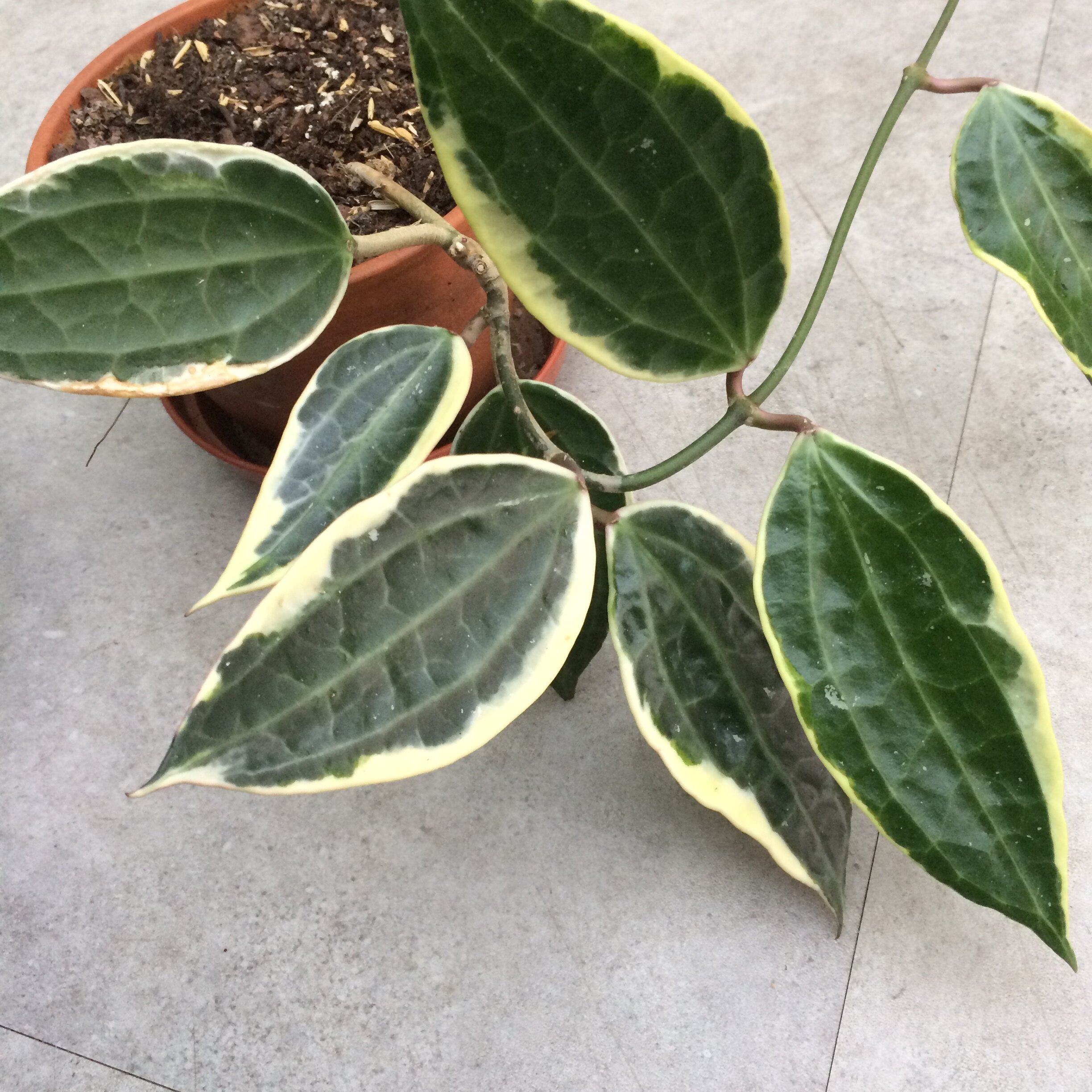
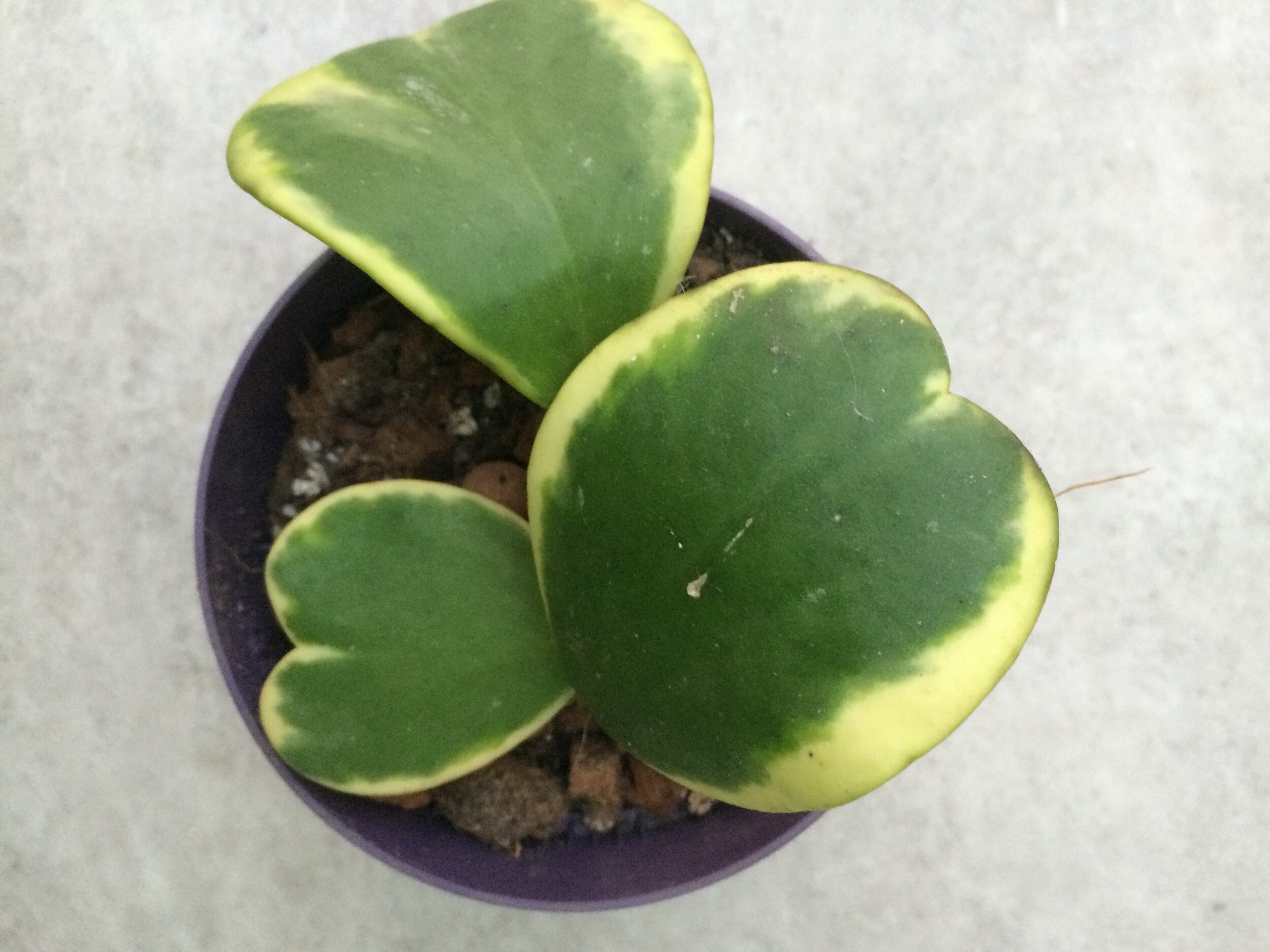
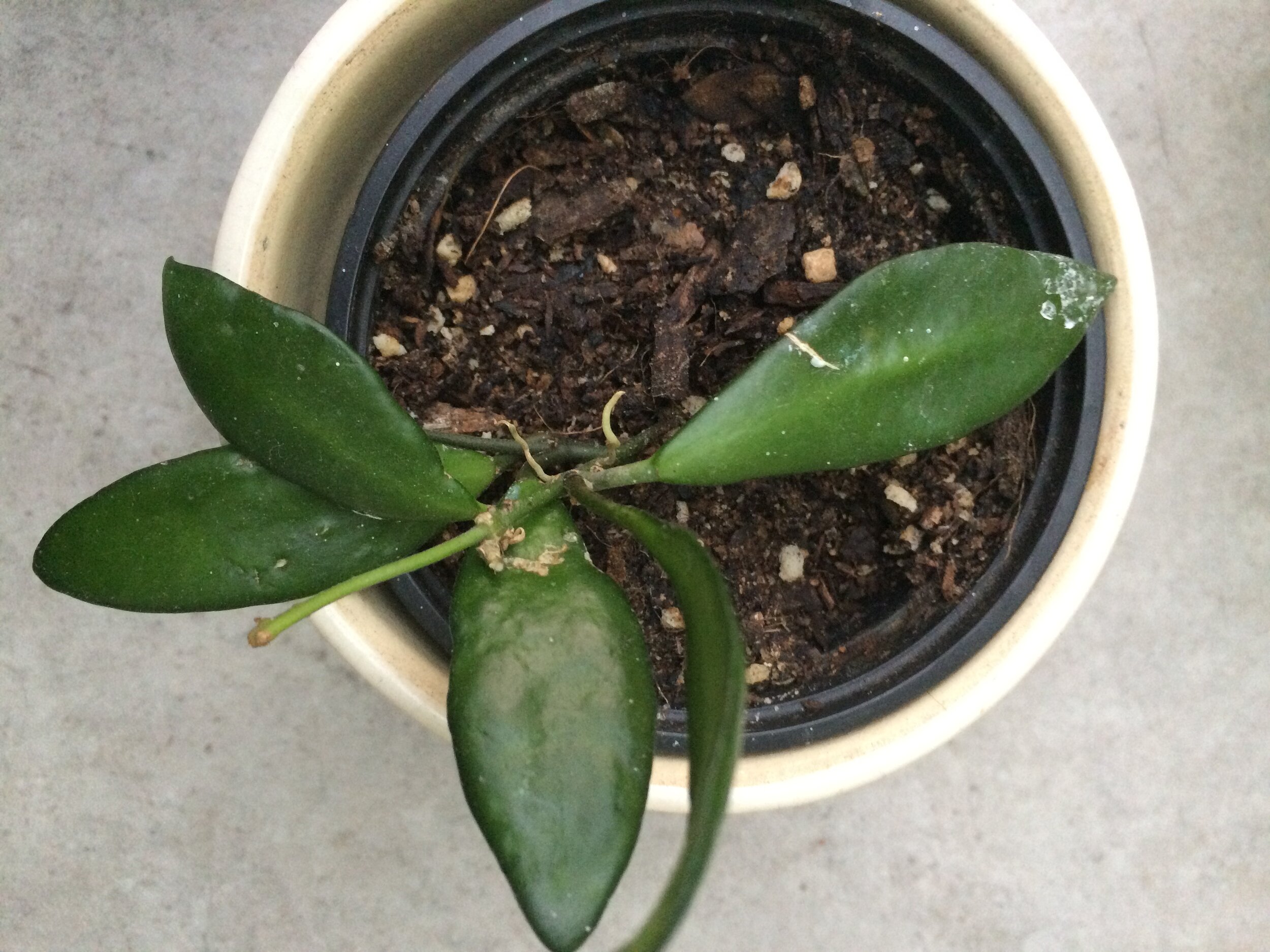
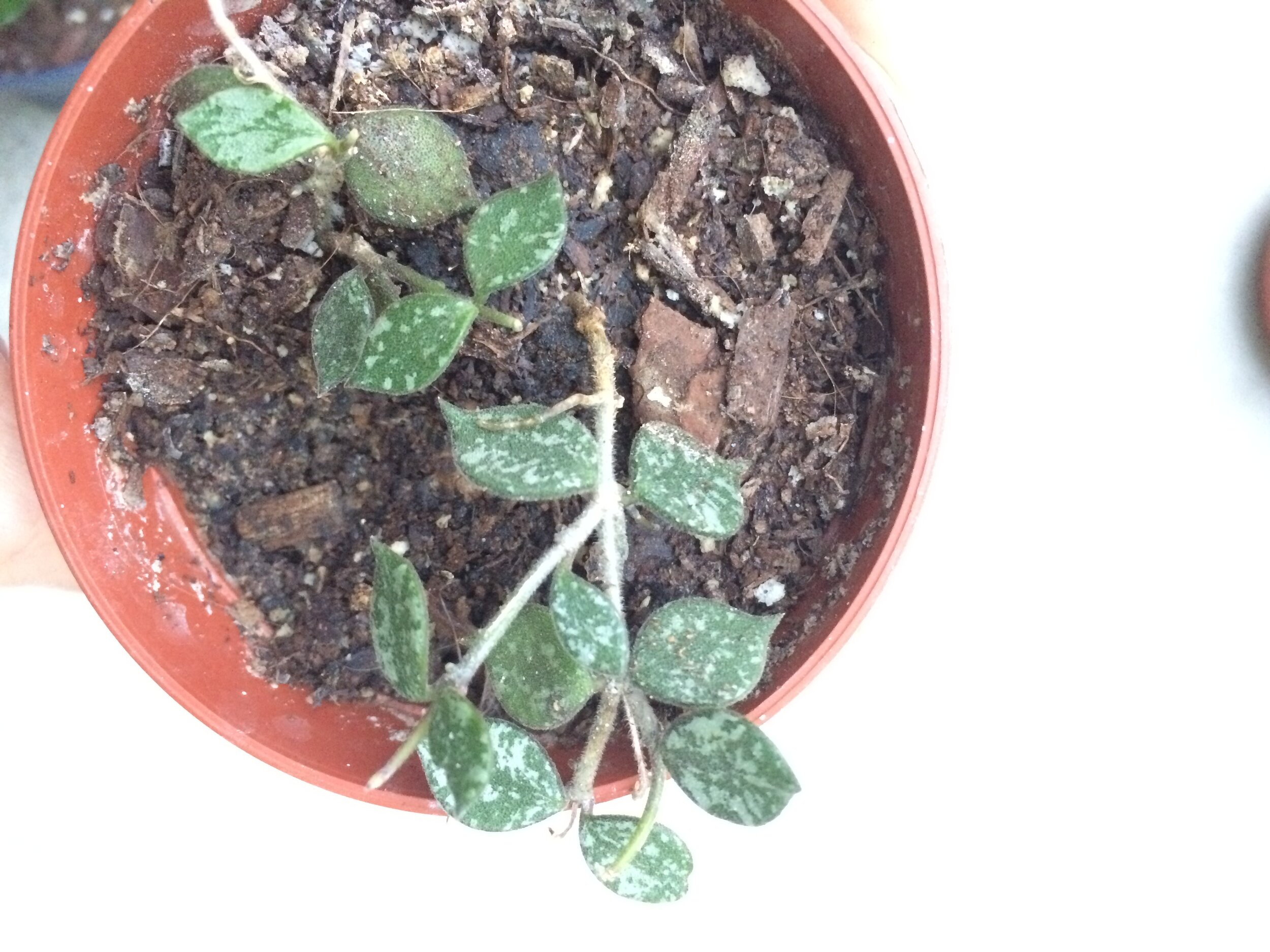
QUESTION OF THE WEEK
Michelle got in touch via Twitter where I’m @janeperrone. Michelle’s aralia, Polyscias scutellaria ‘Fabian’, scored at an estate sale - result! - is looking rather leggy. I advise waiting until spring, then cutting one of the stems back to near the base, just above a node. This should prompt some growth. A staged process of cutting back requires patience, but will also get the best results in the long run. Make sure you use a clean knife or pair of scissors and make sure you’re improving conditions for your plant to try to prevent leaf drop happening again.
Ashley’s plant: click to enlarge the image.
I’d also like your help on another query. Ashley’s Rhaphidophora tetrasperma has developed dark green patches on the underside of the leaves and is undergoing heavy guttation. Ashley writes: “I bottom watered it the other day because the soil seemed very dry, even with the finger test though the roots kept getting in the way so I may not have checked as far down as I should have. It had been a couple weeks since I watered I believe. Is my plant okay? Should I be worried? I don’t know if the dark patches were there prior to watering. I’m not even sure what made me check! I've had this plant since about mid November. I also moved to another location at the end of November. My apartment doesn’t get much light but it’s under a grow light with all my other aroids which seem fine.”
I wondered if the problem was oedema caused by too much water around the roots, but would love to know your thoughts!
Want to ask me a question? Email ontheledgepodcast@gmail.com. The more information you can include, the better - pictures of your plant, details of your location and how long you have had the plant are always useful to help solve your issue!
HOW TO SUPPORT ON THE LEDGE
Contributions from On The Ledge listeners help to pay for all the things that have made the show possible over the last few years: equipment, travel expenses, editing, admin support and transcription.
Want to make a one-off donation? You can do that through my ko-fi.com page, or via Paypal.
Want to make a regular donation? Join the On The Ledge community on Patreon! Whether you can only spare a dollar or a pound, or want to make a bigger commitment, there’s something for you: see all the tiers and sign up for Patreon here.
The Crazy Plant Person tier just gives you a warm fuzzy feeling of supporting the show you love.
The Ledge End tier gives you access to two extra episodes a month, known as An Extra Leaf, as well as ad-free versions of the main podcast on weeks where there’s a paid advertising spot, and access to occasional patron-only Zoom sessions.
My Superfan tier earns you a personal greeting from me in the mail including a limited edition postcard, as well as ad-free episodes.
If you like the idea of supporting On The Ledge on a regular basis but don't know what Patreon's all about, check out the FAQ here: if you still have questions, leave a comment or email me - ontheledgepodcast@gmail.com. If you're already supporting others via Patreon, just click here to set up your rewards!
If you prefer to support the show in other ways, please do go and rate and review On The Ledge on Apple Podcasts, Stitcher or wherever you listen. It's lovely to read your kind comments, and it really helps new listeners to find the show. You can also tweet or post about the show on social media - use #OnTheLedgePodcast so I’ll pick up on it!
CREDITS
This week's show featured the tracks Roll Jordan Roll by the Joy Drops, I Snost, I Lost by Doctor Turtle and Whistle by BenJamin Banger (@benjaminbanger on Insta; website benjaminbanger.com).
Logo design by Jacqueline Colley.


